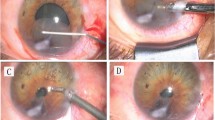Abstract
TA is a 43-year-old man who presented to his ophthalmologist with complaints of intermittent pain and blurred vision in his right eye. The visual acuity was 20/20 in both eyes, and intraocular pressure was measured to be 21 mm in the right eye and 16 mm in the left. Slit-lamp examination showed narrowing of the temporal angle of the right eye, and gonioscopy confirmed a closed angle temporally but a 2+ open angle superiorly, nasally, and inferiorly. The opposite eye had a 2 to 3+ open angle for 360°.
You have full access to this open access chapter, Download chapter PDF
Similar content being viewed by others
Keywords
These keywords were added by machine and not by the authors. This process is experimental and the keywords may be updated as the learning algorithm improves.
TA is a 43-year-old man who presented to his ophthalmologist with complaints of intermittent pain and blurred vision in his right eye. The visual acuity was 20/20 in both eyes, and intraocular pressure was measured to be 21 mm in the right eye and 16 mm in the left. Slit-lamp examination showed narrowing of the temporal angle of the right eye, and gonioscopy confirmed a closed angle temporally but a 2+ open angle superiorly, nasally, and inferiorly. The opposite eye had a 2 to 3+ open angle for 360°.
Immersion ultrasound using a 50-MHz probe demonstrated large ciliary and retroiridial cysts that bowed the iris anteriorly and closed the temporal angle (Fig. 1). Because of the chronic nature of the problem in this patient, it was elected to treat him with topical medication to lower the pressure and defer surgical intervention pending uncontrollable pressure from further angle closure.
Focal angle closure can also be a result of epithelial “pearl” formation and retained cortex in the capsular bag. This can create a mass effect with mechanical pressure on the iris that bows it forward and narrows the angle.
Author information
Authors and Affiliations
Rights and permissions
Copyright information
© 2014 Springer Science+Business Media New York
About this chapter
Cite this chapter
Harrie, R.P., Kendall, C.J. (2014). Case Study 168 Iris Cyst with Angle Closure. In: Clinical Ophthalmic Echography. Springer, New York, NY. https://doi.org/10.1007/978-1-4614-7082-3_168
Download citation
DOI: https://doi.org/10.1007/978-1-4614-7082-3_168
Published:
Publisher Name: Springer, New York, NY
Print ISBN: 978-1-4614-7081-6
Online ISBN: 978-1-4614-7082-3
eBook Packages: MedicineMedicine (R0)





